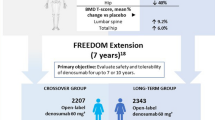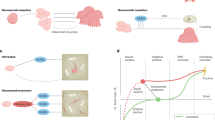Abstract
Denosumab is the first fully human monoclonal antibody that inhibits the formation, function, and survival of osteoclasts by blocking the interaction of receptor activator of nuclear factor-κB (RANK) ligand with its osteoclastic receptor RANK. Clinical studies have shown that the decreased bone resorption and increased bone mineral density resulting from the use of denosumab 60 mg twice yearly entail significant risk reduction of vertebral, hip, and nonvertebral fractures in women with postmenopausal osteoporosis, with an acceptable rate of side effects so far. Following its approval by the US Food and Drug Administration and the European Medicines Agency, a number of clinical trials with denosumab are ongoing to demonstrate its value for other indications and to further characterize its effects on immunomodulation. Denosumab offers a new choice for the treatment of postmenopausal osteoporosis in patients at high risk for fracture.

Similar content being viewed by others
Abbreviations
- DECIDE:
-
Determining Efficacy: Comparison of Initiating Denosumab Versus Alendronate
- DEFEND:
-
Denosumab Fortifies Bone Density
- FREEDOM:
-
Fracture Reduction Evaluation of Denosumab in Osteoporosis Every 6 Months
- STAND:
-
Study of Transitioning from Alendronate to Denosumab.
References
Papers of particular interest, published recently, have been highlighted as: • Of importance •• Of major importance
Heaney R. Remodeling and skeletal fragility. Osteoporos Int 2003, 14 (Suppl 5): S12–S15
Pivonka P, Zimak J, Smith DW. Model structure and control of bone remodeling: a theoretical study. Bone 2008, 43: 249–263
Lacey DL, Timms E, Tan HL, et al. Osteoprotegerin ligand is a cytokine that regulates osteoclast differentiation and activation. Cell 1998, 93: 165–176
Hsu H, Lacey DL, Dunstan CR, et al. Tumor necrosis factor receptor family member RANK mediates osteoclast differentiation and activation induced by osteoprotegerin ligand. Proc Natl Acad Sci USA 1999, 96: 3540–3545
Li J, Sarosi I, Yan XQ, et al. RANK is the intrinsic hematopoietic cell surface receptor that controls osteoclastogenesis and regulation of bone mass and calcium metabolism. Proc Natl Acad Sci USA 2000, 97: 1566–1571
Simonet WS, Lacey DL, Dunstan CR, et al. Osteoprotegerin: a novel secreted protein involved in the regulation of bone density. Cell 1997, 89: 309–319
Hofbauer LC, Schoppet M. Clinical implications of the osteoprotegerin/RANKL/RANK system for bone and vascular diseases. JAMA 2004, 282: 490–495
Ominsky MS, Kostenuik PJ, Cranmer P, et al. The RANKL inhibitor OPG-Fc increases cortical and trabecular bone mass in young gonad-intact cynomolgus monkeys. Osteoporos Int 2007, 18: 1073–1082
Bekker PJ, Holloway DL, Rasmussen AS, et al. A single-dose placebo-controlled study of AMG 162, a fully human monoclonal antibody to RANKL, in postmenopausal women. J Bone Miner Res 2004, 19: 1059–1066
McClung MR, Lewiecki EM, Cohen SB, et al. Denosumab in post menopausal women with low bone mineral density. N Engl J Med 2006, 354: 821–831
Lewiecki EM, Miller PD, McClung MR, et al. Two-year treatment with denosumab (AMG 162) in a randomized phase 2 study of postmenopausal women with low BMD. J Bone Miner Res 2007, 22: 1832–1841
• Miller PD, Bolognese MA, Lewiecki EM, et al. Effect of denosumab on bone density and turnover in postmenopausal women with low bone mass after long-term continued, discontinued, and restarting of therapy. A randomized blinded phase 2 clinical trial. Bone 2008, 43: 222–229. This discusses the 4-year extension of the phase 2 denosumab clinical trial data showing the rapid offset effects on BMD and BTM on discontinuation of denosumab and maintenance of the response to denosumab upon rechallenge.
Miller PD, Bolognese MA, Lewiecki EM, et al. Effects of denosumab on bone mineral density and biochemical markers of bone turnover: 6 year results of a phase 2 clinical trial. Available from: http://www.asbmr.org/Meetings/AnnualMeeting/AbstractDetail.aspx?aid=1cf516b5-29be-4edf-b1ed-7fa92b4f2031 [last accessed 01 September 2010]
Bone HG, Bolognese MA, Yuen CK, et al. Effects of denosumab on bone mineral density and bone turnover in postmenopausal women. J Clin Endocrinol Metab 2008, 93: 2149–2157
•• Cummings SR, San Martin J, McClung MR, et al. Denosumab for prevention of fractures in postmenopausal women with osteoporosis. N Engl J Med 2009, 361: 756–765. This is the pivotal clinical trial showing a significant reduction in vertebral, hip, and nonvertebral fracture risk with denosumab in postmenopausal women with osteoporosis.
• Brown JP, Prince RL, Deal C, et al. Comparison of the effect of denosumab and alendronate on BMD and biochemical markers of bone turnover in postmenopausal women with low bone mass: a randomized, blinded, phase 3 trial. J Bone Miner Res 2009, 24: 153–161. This phase 3, multicenter, double-blind study compared the efficacy and safety of denosumab with alendronate in postmenopausal women with low bone mass, showing that denosumab induced significantly larger gains in BMD and greater reduction in BTMs compared with alendronate.
Kendler DL, Roux C, Benhamou CL, et al. Effects of denosumab on bone mineral density and bone turnover in postmenopausal women transitioning from alendronate therapy. J Bone Miner Res 2010, 25: 72–81
• Reid I, Miller P, Brown J, et al. Effects of denosumab on bone histomorphometry: The freedom and stand studies. J Bone Miner Res 2010 Jun 8. [Epub ahead of print]. This is the first description of bone histomorphometry with denosumab use confirming that this agent produces a potent and sustained inhibition of bone turnover and maintains normal bone microarchitecture without evidence of adverse effects on mineralization.
Seeman E, Delmas PD, Hanley DA,et al. Microarchitectural deterioration of cortical and trabecular bone: differing effects of denosumab and alendronate. J Bone Miner Res 2010, 25: 1886–1894
Block G, Bone HG, Fang L, et al. A single dose study of denosumab in patients with various degrees of renal impairment. Am J Kid Dis 2010, 55: A46
Cohen SB, Dore RK, Lane NE,et al. Denosumab treatment effects on structural damage, bone mineral density, and bone turnover in rheumatoid arthritis: a twelve-month, multicenter, randomized, double-blind, placebo-controlled, phase II clinical trial. Arthritis Rheum 2008, 58: 1299–1309
Smith MR, Egerdie B, Hernández Toriz N,et al. Denosumab in men receiving androgen-deprivation therapy for prostate cancer. N Engl J Med 2009, 361: 745–755
Ellis GK, Bone HG, Chlebowski R, et al. Randomized trial of denosumab in patients receiving adjuvant aromatase inhibitors for non-metastatic breast cancer. J Clin Oncol 2008, 26: 4875–4882
Fizazi K, Carducci MA, Smith MR, et al. A randomized phase III trial of denosumab versus zolendronic acid in patients with bone metastases from castration-resistant prostate cancer. J Clin Oncol 2010, 28 (Suppl): 18 S
Vadhan-Raj S, Henry DH, von Moos R, et al. Denosumab in the treatment of bone metastases from advanced cancer or multiple myeloma (MM): analysis from a phase III randomized trial. J Clin Oncol 2010, 28 (Suppl): 15 S
Stopeck A, Body JJ, Fujiwara Y, et al. Denosumab versus zolendronic acid for the treatment of breast cancer patients with bone metastases: results of a randomized phase III study. Eur J Can Suppl 2009, 7: 2
Toulis A, Anastasilakis D. Increased risk of serious infections in women with osteopenia or osteoporosis treated with denosumab. Osteoporosis Int 2010, 21: 1963–1964.
Disclosure
Conflicts of interest: C.E. Bogado, J.A. Boailchuk, F.E. Massari, and J.R. Zanchetta have received travel expenses from Amgen for research protocol meetings; J.R. Zanchetta: has been a consultant for Amgen and has received honoraria from Amgen for research protocol.
Author information
Authors and Affiliations
Corresponding author
Rights and permissions
About this article
Cite this article
Bogado, C.E., Zanchetta, M.B., Boailchuk, J.A. et al. Denosumab: What’s New?. Curr Osteoporos Rep 9, 12–19 (2011). https://doi.org/10.1007/s11914-010-0040-1
Published:
Issue Date:
DOI: https://doi.org/10.1007/s11914-010-0040-1




